Mục tiêu: Hình thành kiến thức và kỹ năng đọc hiểu cho người học để người học có thể đọc được một số tài liệu liên quan đến vật liệu điện bằng tiếng Anh.
3.1. Conducting Materials
Conducting materials are classified as low resistivity materials and high resistivity materials.
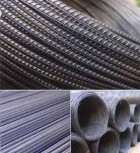
Low resistivity materials: The conducting materials having resistivity between 10-8 to 10-6 ohm-m come under this category and are used in transmission and distribution lines, transformers and motor windings such as copper, aluminium, steel, …
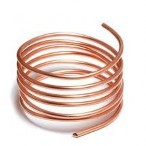
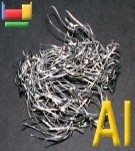
Copper aluminium steel Properties:
a) Low temperature coefficient: For minimum variations in voltage drop and power loss with the change in temperature, these materials should have low temperature coefficient.
Có thể bạn quan tâm!
-
 Tiếng Anh chuyên ngành Nghề Điện tử công nghiệp - CĐ Công nghiệp và Thương mại - 1
Tiếng Anh chuyên ngành Nghề Điện tử công nghiệp - CĐ Công nghiệp và Thương mại - 1 -
 Tiếng Anh chuyên ngành Nghề Điện tử công nghiệp - CĐ Công nghiệp và Thương mại - 3
Tiếng Anh chuyên ngành Nghề Điện tử công nghiệp - CĐ Công nghiệp và Thương mại - 3 -
 Tiếng Anh chuyên ngành Nghề Điện tử công nghiệp - CĐ Công nghiệp và Thương mại - 4
Tiếng Anh chuyên ngành Nghề Điện tử công nghiệp - CĐ Công nghiệp và Thương mại - 4 -
 Tiếng Anh chuyên ngành Nghề Điện tử công nghiệp - CĐ Công nghiệp và Thương mại - 5
Tiếng Anh chuyên ngành Nghề Điện tử công nghiệp - CĐ Công nghiệp và Thương mại - 5
Xem toàn bộ 134 trang tài liệu này.
b) Sufficient mechanical strength: These materials must withstand the mechanical stresses developed during its use for particular applications.
c) Ductility: The material to be used for conductors must be ductile so that it can be drawn and moulded into different sizes and shapes.
d) Solderability: The conducting materials are required to be joined and the joint must have minimum contact resistance. These materials must have a good solderability.
e) Resistance to corrosion: The material should have a high resistance to corrosion so that it should not be corroded when used in different environmental conditions.
High resistivity materials: The conducting materials having resistivity between 10-6 to 10-3 ohm-m come under this category and are used for making resistance elements for heating devices, precision instruments, rheostats etc such as manganin, nichrome, mercury, platinum, carbon and tungsten, …
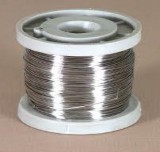

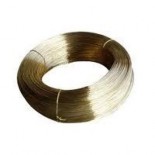
manganin nichrome mercury
Properties:
a) Low temperature coefficient: For minimum variations in voltage drop and power loss with the change in temperature, these materials should have low temperature coefficient.
b) High melting point: These materials, which are used as heating elements should have high melting point.
c) Ductility: The material to be used for conductors must be ductile so that it can be drawn and moulded into different sizes and shapes.
d) Oxidation resistance: The material should have a high oxidation resistance so that it should get oxidised when used in different environmental conditions.
e) High mechanical strength: These materials must withstand the mechanical stresses developed during its use for particular applications.
Copper: Properties
1) It is reddish brown in colour.
2) It is malleable and ductile and can be cast, forged, rolled, drawn and machined.
3) It melts at 10830C.
4) It easily alloys with other metals.
5) Electrical resistivity of copper is 1.7x10-8 Ω-m.
6) Tensile strength for copper is 210 MN/m2.
7) It is highly resistant to corrosion.
8) It is a non-magnetic material.
Applications: Copper is used in conductor wires, coil windings of generators and transformers, cables,
Aluminium: Properties
1) Pure aluminium is silver white in colour.
2) It is a ductile metal and can be put to a shape by rolling, drawing and forging.
3) It melts at 6550 C.
4) It is resistant to corrosion.
5) Its tensile strength is 60MN/m2.
6) It can be alloyed with other elements.
7) Annealing can soften it.
8) It has a higher thermal conductivity.
Applications: Aluminium is widely used as conductor for power
busbars etc. Alloys of copper (like Brass, Bronze, Constantan, Manganin etc) are very useful for different purposes.
3.2. Semiconducting Materials
transmission and distribution. It is used in overhead transmission lines, busbars, ACSR conductors etc.
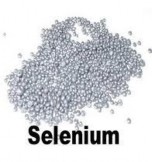
These are the materials, which possess the electrical resistivity in between that of conductors and insulators. They are used for the manufacture of diodes and transistors. Also the number of valence electrons is equal to four. There is a small forbidden energy gap of about 1eV between the conduction and the valence band. Examples: germanium, silicon, selenium, etc.
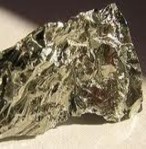
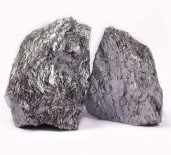
germanium silicon
Properties:
Substances like carbon, silicon, germanium whose electrical conductivity lies in between the conductors and insulators are known as semiconductors. The valence band of these substances is almost filled, but the conduction band is almost empty. The forbidden energy gap between valence and conduction band is very small (1ev). Therefore comparatively a smaller electric field is required to push the valence electrons to the conduction band. This is the reason, why such materials under ordinary conditions do not conduct current and behaves as an insulator. Even at room temperature, when some heat energy is imparted to the valence electrons, a few of them cross over to the conduction band imparting minor conductivity to the semiconductors. As the temperature is increased, more valence electrons cross over to the conduction band and the conductivity of the material increases. Thus these materials have negative temperature co- efficient of resistance.
3.3. Insulating Materials
These are the materials, which do not allow the current to pass through them without any appreciable loss. They have very high electrical
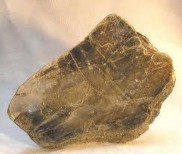
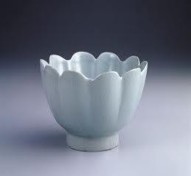
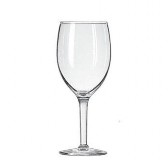
resistance and are also available in a large variety to cover different applications. Some of the specific insulating materials are used for the purpose of storing of an electrical energy and are called dielectric materials such as mica, ceramic, paper etc. These materials are used as a dielectric in capacitors. Also the number of valence electrons is more than four. The energy gap between valence and conduction band is very large (more than 5-6 eV). Examples: Mica, rubber, ceramics, glass, diamond etc.
mica
ceramics glass
Plastic materials can be classified into thermoplastic and thermosetting plastics.
Thermoplastic materials:
The properties of these plastic materials do not change considerably if they are melted and then cooled and solidify. They can be repeatedly melted or dissolved in various solvents. They are more elastic, less brittle and do not lose elasticity when subjected to prolonged heating. They are less apt to age thermally. They can be remoulded again and again in any shape after heating. Many of them possess extraordinary high insulating properties and are water repellent. They are polymers of linear structure, i.e. their molecules are elongated and are thread like. This, type of structure is fusible, soluble, highly plastic, capable of forming thin flexible threads and films. Examples are Polytetra Flouroethylene (P.T.F.E. or Teflon), Polyvinyl Chloride (P.V.C.).
Thermosetting Plastic Materials:
They undergo great changes when subjected to high temperatures for quite sometimes. They are said to be baked and no longer can melt or be dissolved. They are less elastic, more brittle and lose their elasticity when subjected to prolonged heating. So they cannot be remoulded in different shapes once they are set and hardened. They are used, when an insulation is to withstand high temperatures without melting or losing its shape and mechanical strength. Thermosetting plastic substances are space- polymers and the molecules branch off in various directions during polymerisation.
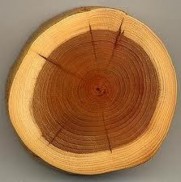
Examples of the natural insulating materials are cotton, rubber, wood, mica.

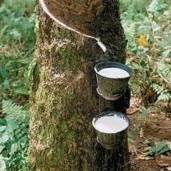
cotton Rubber wood
3.4. Magnetic Materials
Soft magnetic materials:
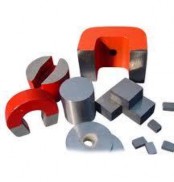
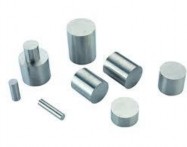
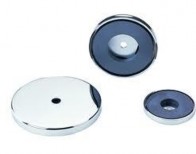
They have small enclosed area of hysteresis loop, high permeability, high saturation value, low eddy current losses which are achieved by using laminated cores, less residual magnetism. Soft magnetic materials retain their magnetism as long as they are energised by an external magnetic field; Example: Alpha iron, super permalloy (Ni-Fe-Mo), silicon ferrite. Soft magnetic materials are used for the construction of cores for electrical machines, transformers, electromagnets reactors and cores of audio frequency couplings and matching transformers in telecommunication.
Hard Magnetic materials:
They have a gradually rising magnetization curve with large hysteresis loop area and hence large energy losses. They have high value of retentivity and high value of coercivity and low permeability. To saturate the hard magnetic materials, a high magnetizing force is required. Hard magnetic materials have the property of retaining their magnetism even after the magnetising field is removed. Example: Alnico (Al-Ni-Co), Cobalt DE04 steel and retaining the same for a long time. Due to this property they are used in the manufacture of permanent magnets.
3.5. Special Materials
Each of the special materials described below has a definite game effect. Some creatures have damage reduction based on their creature type or core concept. Some are resistant to all but a special type of damage, such as that dealt by evil-aligned weapons or bludgeoning weapons. Others are vulnerable to weapons of a particular material. Characters may choose to carry several different types of weapons, depending upon the campaign and types of creatures they most commonly encounter.
Adamantine: This ultrahard metal adds to the quality of a weapon or suit of armor.
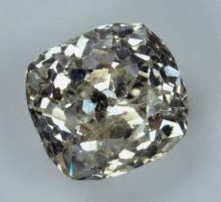
IV. EXERCISE
Mục tiêu: Kiểm tra kết quả đạt được của người học về sự hiểu biết các từ vựng chuyên môn cũng như ngữ pháp, kiến thức và kỹ năng đọc hiểu đã được học để hoàn thành các bài tập ứng dụng cũng như áp dụng vào trong môi trường làm thực tế sau khi tốt nghiệp.
1. Complete the sentences using the words below:
conducting ductilty high (2x) transmission different transformers joint
a) The conducting materials are used in ……………… and distribution lines,
……………… and motor windings.
b) The ………… materials should have low ……………….. coefficient.
c) The conducting ……………….. can be drawn and moulded into ………….. sizes and shapes thanks to its ………………
d) The …………… of the conducting materials must have ………………….. contact resistance.
e) The conducting materials should have a ………… resistance to corrosion.
2. Answer the following questions
a) What are the conducting materials used for?
.............................................................................................................................
.............................................................................................................................
b) Why should the high resistivity materials have low temperature coefficient?
.............................................................................................................................
.............................................................................................................................
c) What are the properties of the copper?
.............................................................................................................................
.............................................................................................................................
d) What are the applications of the copper?
.............................................................................................................................
.............................................................................................................................
e) How much degree does the aluminium melt?
.............................................................................................................................
.............................................................................................................................
3. Decide True or False
a) The semiconducting materials are used to make diodes and transistors.
b) Under ordinary conditions, the semiconducting materials do not conduct current and behaves as an insulator.
c) The insulating materials have very high electrical resistance. ...
d) The properties of thermoplastic materials do not change considerably if they are melted and then cooled and solidify.
e) Soft magnetic materials are used for the construction of cores for electrical machines, transformers. ....
4. Listen and write the missing words:
The hard (1)……….. …. materials have a gradually rising magnetization curve with large hysteresis loop area and hence large energy (2) ……... They have high value of (3) ……….. and high value of coercivity and low (4) …………. To saturate the hard magnetic materials, a high magnetizing (5) ……….. is required. Hard magnetic materials have the property of retaining their (6)
………… even after the magnetising field is(7) ……… . Example: Alnico (Al- Ni-Co), Cobalt DE04 steel and retaining the same for a (8) ………. time. Due to this property (9)……….. are used in the manufacture of permanent (10) …………..
5. Match the ideas
1) Adamantine
2) Darkwood
3) Dragonhide
4) Mithral 5)Conducting materials
a) as hard as normal wood but very light
b) lighter than iron but just as hard.
c) adds to the quality of a weapon or suit of armor
d) has 10 hit points per inch of thickness and hardness 10
e) possess the electrical resistivity in between that of conductors and insulators
6) Semiconductors
7) Insulators
8) Magnetic materials
V. COVERSATION
f) have small enclosed area of hysteresis loop, high permeability, high saturation value, low eddy current losses
g) are classified as low resistivity materials and high resistivity materials.
h) do not allow the current to pass through them without any appreciable loss
Mục tiêu: Hình thành kỹ năng giao tiếp cho người học để người học có tự tin giao tiếp trong môi trường làm việc
Mark: Hi, John!
John: Hi, Mark. How are you?
Mark: I’m fine. Thank you. And you?
John: I’m not bad. My boss usually asks me to buy some electrical materials for the project.
Mark: Oh, so lucky you. You earn some money from that, don’t you?
John: I don’t think so. I go to look everywhere for the materials but I can’t find out all the materials.
Mark: Do you need any help? I will buy insulating materials from my sister’s shop next to my house for you. Don’t worry about it so much.
John: Thanks a lot. See you tomorrow.
Mark: See you.




